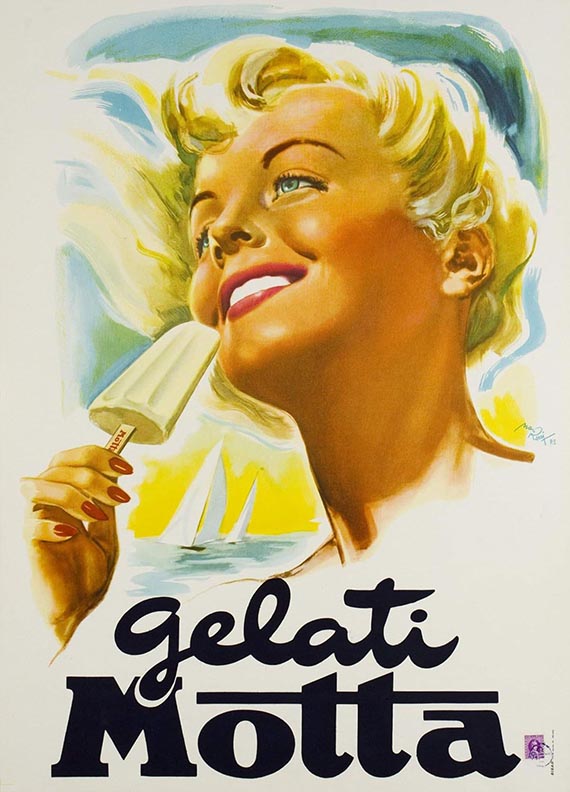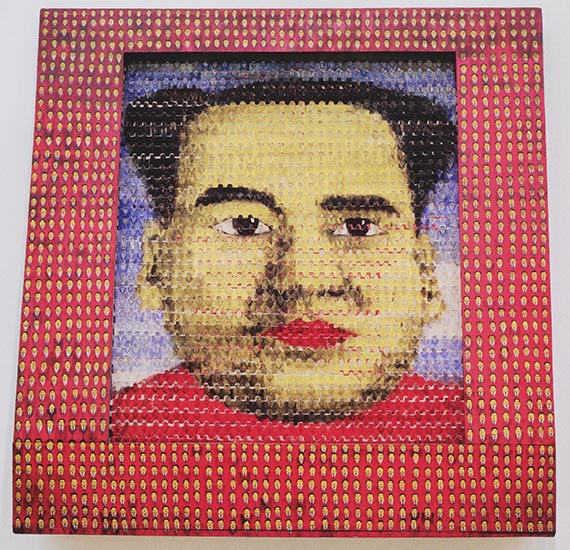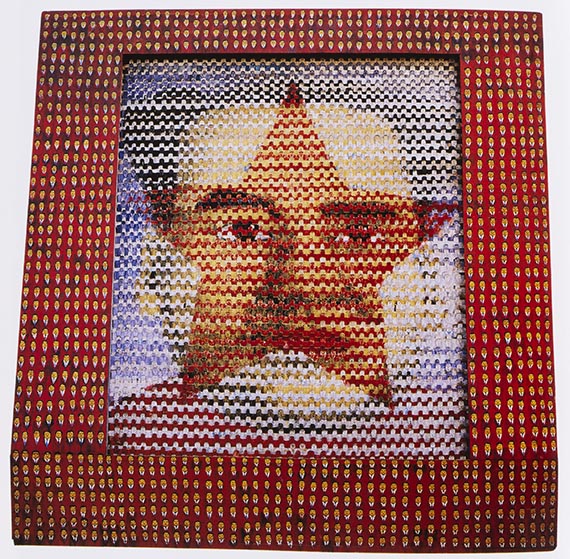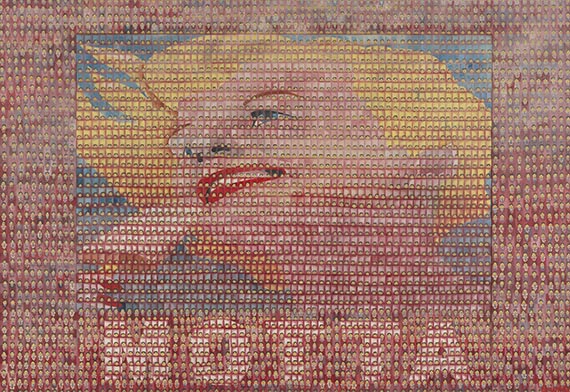Video
Frame image
22
Thomas Bayrle
Motta, 1966.
Oil on panel, in the artist's original frame
Estimate:
€ 100,000 / $ 118,000 Sold:
€ 165,100 / $ 194,818 (incl. surcharge)
Motta. 1966.
Oil on panel, in the artist's original frame.
Signed in the lower right. Once more signed and dated, as well as titled "Motta Love" on the reverse. 126.5 x 182.5 cm (49.8 x 71.8 in).
[AR].
• Early highlight from a particularly sought-after creative period of the German Pop Art pioneer.
• Thomas Bayrle confronts "Motta Eis-Sommer-Feeling" with political motifs; capitalism and consumerism meet communism.
• 3612 heads: In the mid-1960s, he developed his distinctive grid-like style.
• From Frankfurt to New York: since 2002, the artist's work has been featured in major museum solo shows.
• In private family ownership since the late 1960s, purchased directly from the artist.
•Until the end of February 2025, Bayrle's works were part of the “Pop Forever. Tom Wesselmann &..” exhibition at the Fondation Louis Vuitton in Paris.
• Other works from the 1960s can be found in international museum collections such as the Museum of Modern Art, New York, the Städel Museum, Frankfurt am Main, and the Neue Nationalgalerie, Berlin.
• In 2026, two retrospective exhibitions will be dedicated to the artist: at the Schirn Kunsthalle in Frankfurt am Main and at the Museum Kulturspeicher in Würzburg.
PROVENANCE: Private collection Germany/Switzerland (acquired fromt the artist in the late 1960s).
Ever since family-owned.
EXHIBITION: Thomas Bayrle, Städel Museum, Frankfurt a. Main, October 19, 2002 - January 5, 2003, cat. no. 9 (illustrated in color on p. 33).
Thomas Bayrle. 40 Years Chinese Rock 'n' Roll, Museum of Modern Art, Frankfurt a. Main, March 17, 2006 - January 28, 2007, cat. no. 8 (illustrated in color).
Thomas Bayrle. I've a feeling we're not in Kansas anymore, Museu d'Art Contemporani (MACBA), Barcelona, February 6 - April 19, 2009.
Thomas Bayrle. Tutto-in-uno / All-in-One, Museo Madre, Naples, June 21 - October 14, 2013 (with color plate on p. 24).
Thomas Bayrle. Playtime, New Museum, New York, June 20 - September 2, 2018 (illustrated in color on pp. 62-63).
Thomas Bayrle. Form Form SuperForm, Pinacoteca Agnelli, Turin, November 3, 2023 - August 31, 2024 (illustrated in color on pp. 74-75).
LITERATURE: Thomas Bayrle, Cities, Accumulations and Eros, Tokyo 1982, No. 2.
Thomas Bayrle, Bayrle. Big Book, Cologne 1992, p. 13.
Museum für Moderne Kunst Frankfurt am Main, Thomas Bayrle, Darmstadt 1994, No. 29.
Renato Barilli, Un mosaico (quasi) pop. Al Madre di Napoli omaggio a Thomas Bayrle, July 19, 2013, in: l'Unità, Year 90, no. 196, p. 21 (with color reproduction).
Thomas Bayrle (ed.), Thomas Bayrle. Gerani / Pavesi, Berlin 2015 (illustrated on p. 15).
Anne Blood, Thomas Bayrle. Playtime, July 8, 2018, online: studio international (with installation view, accessed on March 3, 2025).
Alessandra Quattordio, Thomas Bayrle, ovvero la moltiplicazione dei segni. Tra consumismo e denuncia, November 20, 2023, online: ArtsLife, the cultural revolution online (with color reproduction, accessed on March 3, 2025).
"At the time, I was interested in mass gatherings, mass production and mass society, regardless of whether it was about goods or people. Without much consideration, I associated mass rallies in the East with commercial production in the West, seeing it as the same thing under a different guise."
Thomas Bayrle in an interview with Marius Babias, Kunstofrum International, volume 148, Dec. 1999, p. 237.
Oil on panel, in the artist's original frame.
Signed in the lower right. Once more signed and dated, as well as titled "Motta Love" on the reverse. 126.5 x 182.5 cm (49.8 x 71.8 in).
[AR].
• Early highlight from a particularly sought-after creative period of the German Pop Art pioneer.
• Thomas Bayrle confronts "Motta Eis-Sommer-Feeling" with political motifs; capitalism and consumerism meet communism.
• 3612 heads: In the mid-1960s, he developed his distinctive grid-like style.
• From Frankfurt to New York: since 2002, the artist's work has been featured in major museum solo shows.
• In private family ownership since the late 1960s, purchased directly from the artist.
•Until the end of February 2025, Bayrle's works were part of the “Pop Forever. Tom Wesselmann &..” exhibition at the Fondation Louis Vuitton in Paris.
• Other works from the 1960s can be found in international museum collections such as the Museum of Modern Art, New York, the Städel Museum, Frankfurt am Main, and the Neue Nationalgalerie, Berlin.
• In 2026, two retrospective exhibitions will be dedicated to the artist: at the Schirn Kunsthalle in Frankfurt am Main and at the Museum Kulturspeicher in Würzburg.
PROVENANCE: Private collection Germany/Switzerland (acquired fromt the artist in the late 1960s).
Ever since family-owned.
EXHIBITION: Thomas Bayrle, Städel Museum, Frankfurt a. Main, October 19, 2002 - January 5, 2003, cat. no. 9 (illustrated in color on p. 33).
Thomas Bayrle. 40 Years Chinese Rock 'n' Roll, Museum of Modern Art, Frankfurt a. Main, March 17, 2006 - January 28, 2007, cat. no. 8 (illustrated in color).
Thomas Bayrle. I've a feeling we're not in Kansas anymore, Museu d'Art Contemporani (MACBA), Barcelona, February 6 - April 19, 2009.
Thomas Bayrle. Tutto-in-uno / All-in-One, Museo Madre, Naples, June 21 - October 14, 2013 (with color plate on p. 24).
Thomas Bayrle. Playtime, New Museum, New York, June 20 - September 2, 2018 (illustrated in color on pp. 62-63).
Thomas Bayrle. Form Form SuperForm, Pinacoteca Agnelli, Turin, November 3, 2023 - August 31, 2024 (illustrated in color on pp. 74-75).
LITERATURE: Thomas Bayrle, Cities, Accumulations and Eros, Tokyo 1982, No. 2.
Thomas Bayrle, Bayrle. Big Book, Cologne 1992, p. 13.
Museum für Moderne Kunst Frankfurt am Main, Thomas Bayrle, Darmstadt 1994, No. 29.
Renato Barilli, Un mosaico (quasi) pop. Al Madre di Napoli omaggio a Thomas Bayrle, July 19, 2013, in: l'Unità, Year 90, no. 196, p. 21 (with color reproduction).
Thomas Bayrle (ed.), Thomas Bayrle. Gerani / Pavesi, Berlin 2015 (illustrated on p. 15).
Anne Blood, Thomas Bayrle. Playtime, July 8, 2018, online: studio international (with installation view, accessed on March 3, 2025).
Alessandra Quattordio, Thomas Bayrle, ovvero la moltiplicazione dei segni. Tra consumismo e denuncia, November 20, 2023, online: ArtsLife, the cultural revolution online (with color reproduction, accessed on March 3, 2025).
"At the time, I was interested in mass gatherings, mass production and mass society, regardless of whether it was about goods or people. Without much consideration, I associated mass rallies in the East with commercial production in the West, seeing it as the same thing under a different guise."
Thomas Bayrle in an interview with Marius Babias, Kunstofrum International, volume 148, Dec. 1999, p. 237.
Thomas Bayrle's super forms and 1960s German Pop-Art
Thomas Bayrle's artistic career began in the mid-1960s, a decade marked by profound political and cultural changes in Germany. The Federal Republic of Germany experienced an economic boom that favored technical innovations and fundamentally changed consumer behavior. Youth culture, the sexual revolution, and various protest movements also led to a new cultural self-awareness that questioned traditional values and established an alternative lifestyle. In this social environment, the predominantly abstract post-war painting of the 1960s was replaced by a new, figurative movement that was influenced by Pop Art from America and Great Britain. Among its representatives are Gerhard Richter and Konrad Lueg in Düsseldorf, K. H. Hödicke and Lambert Maria Wintersberger in Berlin, and Peter Roehr and Thomas Bayrle in the Frankfurt am Main circle. The son of an artist and an art historian, he began training as a weaver and dyer in Göppingen in 1956. In 1961, he founded the publishing house “Gulliver-Presse” in Bad Homburg together with Bernhard Jäger and worked in advertising, influences that would also be reflected in his art.

His work “Motta” from 1966 is one of the early highlights in Peter Bayerl's oeuvre, created in the cultural environment of the 1960s. It comprises two wooden elements and shows the advertising face of the Italian ice cream maker “Motta” in the center of the picture, with the company name in capital letters below it. From a distance, the overall impression seems oddly gridded. In close-up, it shows that the entire surface in the foreground is covered with miniature portraits reminiscent of postage stamps. Countless male figures with black hair, red jackets, white shirts, and ties look at us with black eyes and red mouths but, at the same time, disappear into the masses due to their uniformity. The male figures are also known from Thomas Bayrle's work “Mao,” also from 1966. It shows a portrait of Mao Zedong in the center of the picture, which can be tilted and converted into a red star with the help of a built-in motor. Like “Motta,” it comprises countless micro-portraits representing the Chinese people. The central motif, which Thomas Bayrle calls a “superform”, is represented by Moa and the red star and is formed there from countless subforms that correspond in content to the superordinate motif. Thomas Bayrle, who was intensively studying Maoism and China at the time, found the inspiration for this form of representation in photographs of Chinese stadiums, which made a strong impression on him: “Images of the Chinese Revolution could be seen on the huge walls of people. These “super signs” were composed of thousands of dots, which on closer inspection proved to be signs [...] picture-patterned grids of thousands of people who, on command, held up or lowered colored signs.” (Thomas Bayrle, in exhibition catalog Thomas Bayrle. 40 Years Chinese Rock 'n' Roll, Museum für Moderne Kunst, Frankfurt a. Main, 2006)


In contrast to “Mao,” in “Motta,” the principle of the “superform” of the advertising face and its subforms, the representatives of the Chinese people, is reversed. Here, the world of capitalism meets the politically connoted motifs of communism unfiltered; mass production meets mass movement, and Western profit-seeking meets the ideas of the largest Eastern people's republic. As Thomas Bayrle himself says, he was never concerned with visualizing ideological contradictions: “I paid little attention to ideological differences and mixed communist and capitalist elements and content together – against the protest of my left-wing friends... According to the motto “technical patterns on this side / organic ornaments on that side,” in my imagination, East and West interwove like warp and weft in the same fabric... Irreconcilable ideological differences became increasingly similar – and blurred over the years – until the currently unfolding “Global Rock ‘n’ Roll.” (Thomas Bayrle, quoted in: MMK Frankfurt a. Main, online: www.mmk.art/de/whats-on/thomas-bayrle - accessed on March 6, 25). Whether consciously or unconsciously, deliberately or by chance, with the work “Motta”, Thomas Bayerle creates a congenial conglomeration of seemingly irreconcilable contradictions and conflicting world views. The work, which had been in private hands since the 1960s, was exhibited in public for the first time in 2002 and has since been shown in almost all of the artist's important solo shows over the past 25 years, which undoubtedly speaks to the great significance of the work in the artist's oeuvre, which began in the epochal 1960s. [AR]
Thomas Bayrle's artistic career began in the mid-1960s, a decade marked by profound political and cultural changes in Germany. The Federal Republic of Germany experienced an economic boom that favored technical innovations and fundamentally changed consumer behavior. Youth culture, the sexual revolution, and various protest movements also led to a new cultural self-awareness that questioned traditional values and established an alternative lifestyle. In this social environment, the predominantly abstract post-war painting of the 1960s was replaced by a new, figurative movement that was influenced by Pop Art from America and Great Britain. Among its representatives are Gerhard Richter and Konrad Lueg in Düsseldorf, K. H. Hödicke and Lambert Maria Wintersberger in Berlin, and Peter Roehr and Thomas Bayrle in the Frankfurt am Main circle. The son of an artist and an art historian, he began training as a weaver and dyer in Göppingen in 1956. In 1961, he founded the publishing house “Gulliver-Presse” in Bad Homburg together with Bernhard Jäger and worked in advertising, influences that would also be reflected in his art.

Mario Rossi, Gelati Motta, 1954, poster.
His work “Motta” from 1966 is one of the early highlights in Peter Bayerl's oeuvre, created in the cultural environment of the 1960s. It comprises two wooden elements and shows the advertising face of the Italian ice cream maker “Motta” in the center of the picture, with the company name in capital letters below it. From a distance, the overall impression seems oddly gridded. In close-up, it shows that the entire surface in the foreground is covered with miniature portraits reminiscent of postage stamps. Countless male figures with black hair, red jackets, white shirts, and ties look at us with black eyes and red mouths but, at the same time, disappear into the masses due to their uniformity. The male figures are also known from Thomas Bayrle's work “Mao,” also from 1966. It shows a portrait of Mao Zedong in the center of the picture, which can be tilted and converted into a red star with the help of a built-in motor. Like “Motta,” it comprises countless micro-portraits representing the Chinese people. The central motif, which Thomas Bayrle calls a “superform”, is represented by Moa and the red star and is formed there from countless subforms that correspond in content to the superordinate motif. Thomas Bayrle, who was intensively studying Maoism and China at the time, found the inspiration for this form of representation in photographs of Chinese stadiums, which made a strong impression on him: “Images of the Chinese Revolution could be seen on the huge walls of people. These “super signs” were composed of thousands of dots, which on closer inspection proved to be signs [...] picture-patterned grids of thousands of people who, on command, held up or lowered colored signs.” (Thomas Bayrle, in exhibition catalog Thomas Bayrle. 40 Years Chinese Rock 'n' Roll, Museum für Moderne Kunst, Frankfurt a. Main, 2006)

Thomas Bayrle, Mao, 1966, oil on panel with electro motor, Neue Nationalgalerie Berlin.© VG Bild-Kunst, Bonn 2025

Other view: Thomas Bayrle, Mao, 1966, oil on panel with electro motor,
Neue Nationalgalerie Berlin. © VG Bild-Kunst, Bonn 2025
Neue Nationalgalerie Berlin. © VG Bild-Kunst, Bonn 2025
In contrast to “Mao,” in “Motta,” the principle of the “superform” of the advertising face and its subforms, the representatives of the Chinese people, is reversed. Here, the world of capitalism meets the politically connoted motifs of communism unfiltered; mass production meets mass movement, and Western profit-seeking meets the ideas of the largest Eastern people's republic. As Thomas Bayrle himself says, he was never concerned with visualizing ideological contradictions: “I paid little attention to ideological differences and mixed communist and capitalist elements and content together – against the protest of my left-wing friends... According to the motto “technical patterns on this side / organic ornaments on that side,” in my imagination, East and West interwove like warp and weft in the same fabric... Irreconcilable ideological differences became increasingly similar – and blurred over the years – until the currently unfolding “Global Rock ‘n’ Roll.” (Thomas Bayrle, quoted in: MMK Frankfurt a. Main, online: www.mmk.art/de/whats-on/thomas-bayrle - accessed on March 6, 25). Whether consciously or unconsciously, deliberately or by chance, with the work “Motta”, Thomas Bayerle creates a congenial conglomeration of seemingly irreconcilable contradictions and conflicting world views. The work, which had been in private hands since the 1960s, was exhibited in public for the first time in 2002 and has since been shown in almost all of the artist's important solo shows over the past 25 years, which undoubtedly speaks to the great significance of the work in the artist's oeuvre, which began in the epochal 1960s. [AR]
22
Thomas Bayrle
Motta, 1966.
Oil on panel, in the artist's original frame
Estimate:
€ 100,000 / $ 118,000 Sold:
€ 165,100 / $ 194,818 (incl. surcharge)
Headquarters
Joseph-Wild-Str. 18
81829 Munich
Phone: +49 89 55 244-0
Fax: +49 89 55 244-177
info@kettererkunst.de
Louisa von Saucken / Undine Schleifer
Holstenwall 5
20355 Hamburg
Phone: +49 40 37 49 61-0
Fax: +49 40 37 49 61-66
infohamburg@kettererkunst.de
Dr. Simone Wiechers / Nane Schlage
Fasanenstr. 70
10719 Berlin
Phone: +49 30 88 67 53-63
Fax: +49 30 88 67 56-43
infoberlin@kettererkunst.de
Cordula Lichtenberg
Gertrudenstraße 24-28
50667 Cologne
Phone: +49 221 510 908-15
infokoeln@kettererkunst.de
Hessen
Rhineland-Palatinate
Miriam Heß
Phone: +49 62 21 58 80-038
Fax: +49 62 21 58 80-595
infoheidelberg@kettererkunst.de
We will inform you in time.




 Lot 22
Lot 22 
